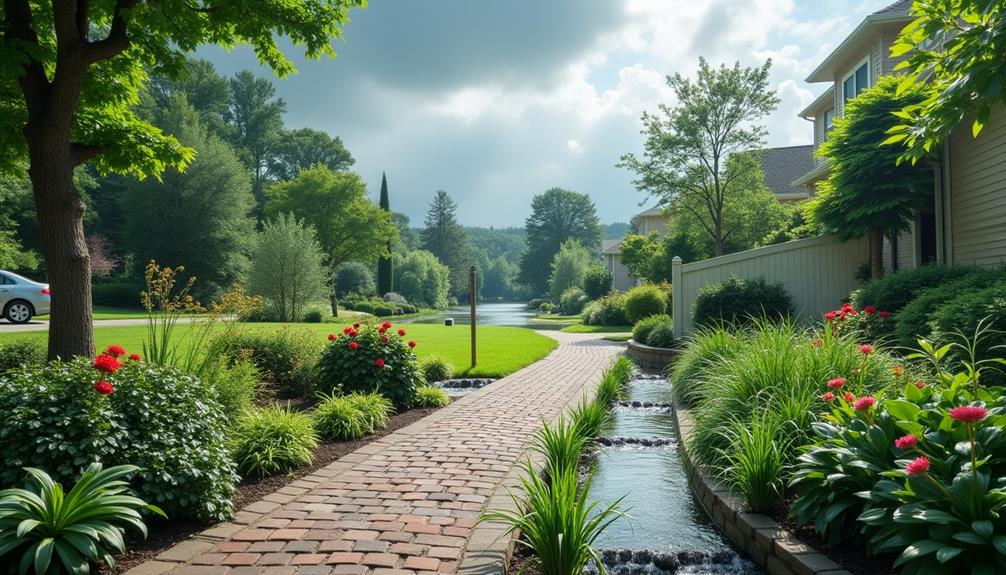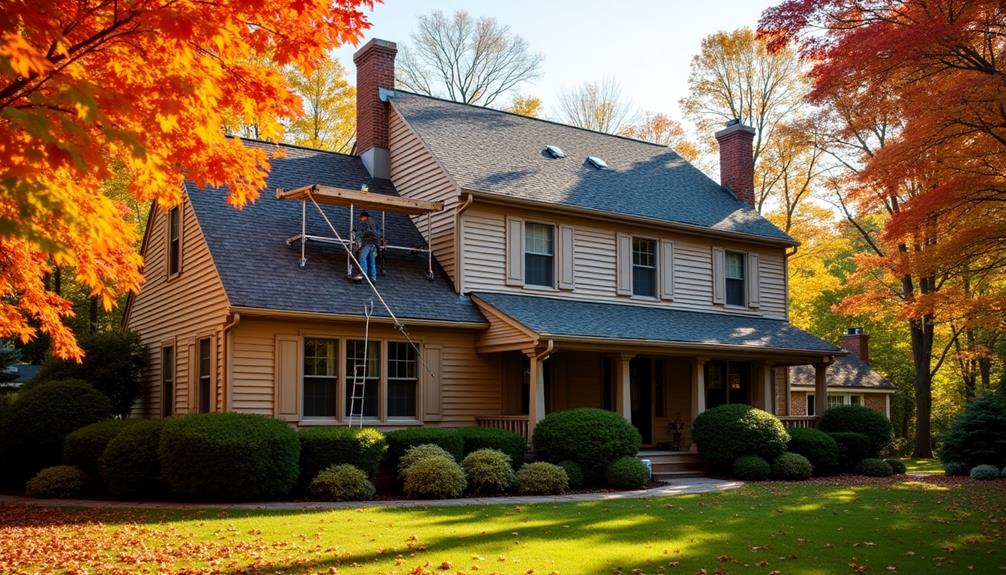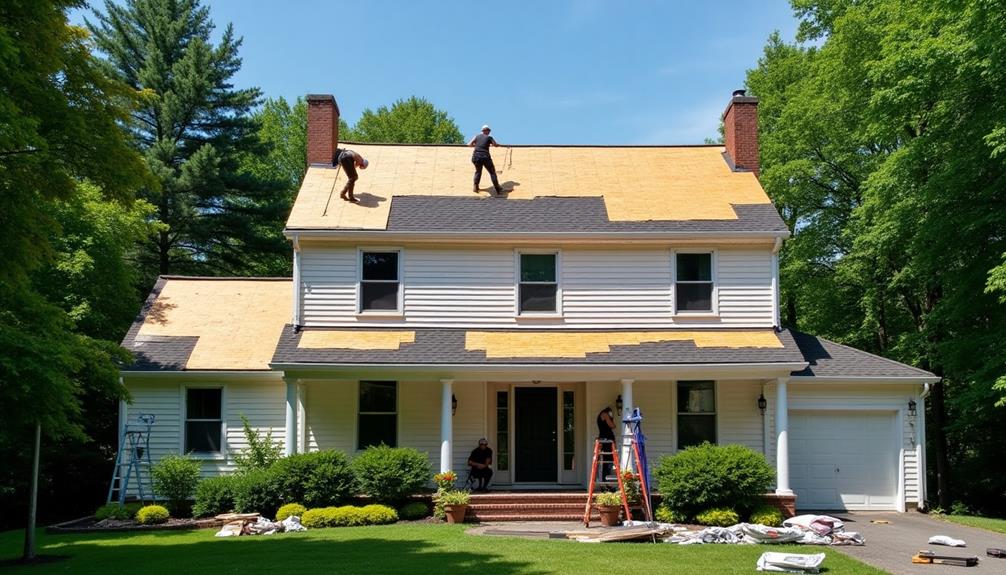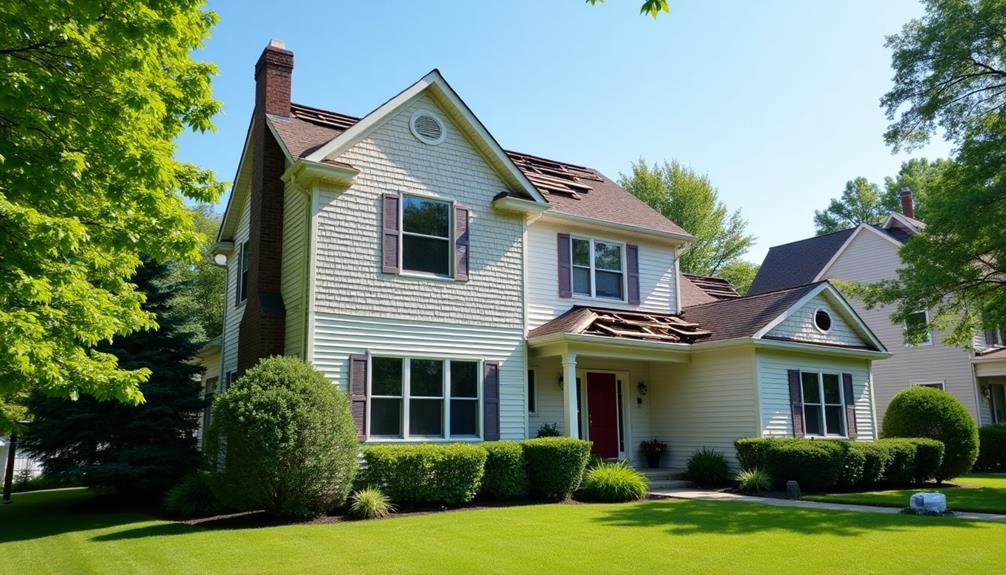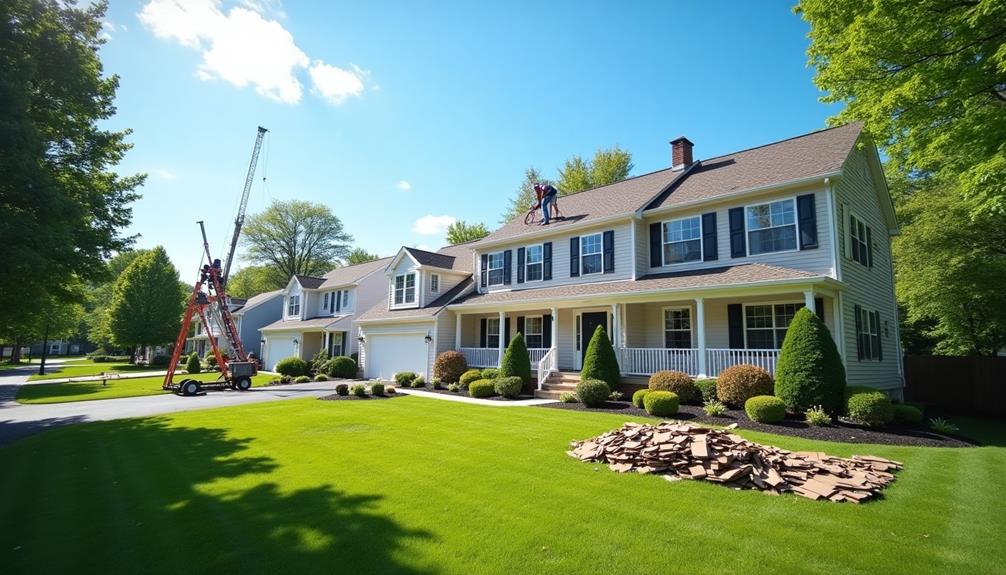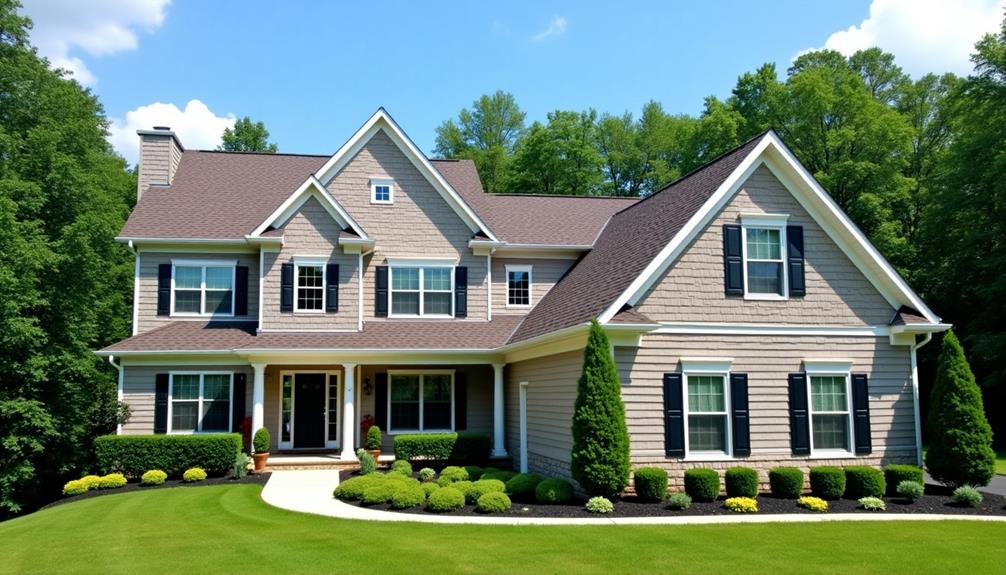It's interesting how you recently noticed a friend's yard thriving despite heavy rains, while yours seems to turn into a mini lake every time it pours. If you're dealing with chronic flooding in your yard, you might want to explore effective drainage solutions to protect your landscape. From French drains to rain gardens, there are various methods to manage excess water. Each option has its own advantages and considerations that could make a significant difference in your yard's health. What might work best for your unique situation?
Understanding Yard Drainage Needs
When it comes to managing excess water, understanding your yard's drainage needs is essential. You can start with a drainage assessment to identify problem areas where water tends to accumulate. This assessment involves inspecting your yard for low spots, compacted soil, and any barriers that might impede proper drainage.
Next, pay attention to soil permeability. This term refers to how easily water can flow through your soil. If you've got clay soil, for instance, it may not drain well, leading to pooling water after heavy rains. On the other hand, sandy soil tends to drain quickly but mightn't retain water when it's needed.
Consider the slope of your yard as well. A slight slope can encourage water to flow away from your home and into designated drainage areas.
French Drains for Effective Water Control
If you're looking to manage excess water in your yard, French drains could be your answer.
You'll want to understand the installation process, keep up with maintenance, and consider the costs involved.
Let's break down how French drains can effectively control water flow in your space.
Installation Process Overview
Installing a French drain is often a straightforward process that can significantly improve water control in flood-prone yards.
First, you'll need to assess your yard's drainage system design. Identify areas where water tends to pool and plan your drain's route, ensuring it slopes away from your home and other structures.
Next, gather your materials: perforated pipe, gravel, and landscape fabric.
Start by digging a trench about 6 inches wide and 18 to 24 inches deep along your planned path. Make sure the trench slopes downward, at least a quarter inch per foot, to promote effective drainage.
Once your trench is ready, lay down the landscape fabric, allowing it to extend beyond the trench edges. This helps with soil erosion prevention by keeping soil from mixing with the gravel.
Place the perforated pipe in the trench, holes facing down, and cover it with gravel. Finally, fold the landscape fabric over the gravel to prevent dirt from clogging the system.
With your French drain properly installed, you'll notice improved drainage, reducing flooding and helping maintain your yard's health.
Maintenance Tips and Tricks
After your French drain is in place, regular maintenance is key to ensuring it continues to function effectively.
Start with seasonal inspections to check for any signs of soil compaction or blockages. You'll want to assess the surrounding landscape for any needed adjustments, as plants and roots can interfere with your drain's performance.
Routine cleaning is essential; remove any debris that could clog the system. Keep an eye on water diversion to ensure it's directing flow away from your home and yard properly.
If you notice erosion in certain areas, consider implementing erosion control measures such as adding rocks or stabilizing plants.
When selecting plants for your yard, choose those that won't compete aggressively with your drainage system. Proper plant selection can enhance both aesthetics and functionality.
Regular drainage assessments will help you identify any potential issues before they escalate.
Cost Considerations Explained
When considering a French drain for effective water control, understanding the costs involved is crucial. First, you'll want to focus on budget planning, as this system can vary significantly in price.
Material costs will depend on the type of piping and gravel you choose, while labor expenses often account for a substantial portion of the overall budget.
To get a clear picture, it's wise to obtain installation quotes from multiple contractors. This way, you can compare prices and find a service that fits your financial plan.
Keep in mind that while the upfront costs may seem high, investing in a French drain can lead to long-term savings. By preventing water damage, you'll minimize future repair costs and maintain your property's value.
Additionally, consider project financing options if you're concerned about immediate expenses. Many companies offer financing plans that can help spread the cost over time, making it more manageable.
Ultimately, weighing these factors will guide you in making an informed decision about installing a French drain to protect your yard from flooding.
Installing Dry Wells for Excess Water
A homeowner's best defense against excess water in flood-prone yards is a dry well. This underground structure collects and stores excess runoff, allowing it to gradually seep into the surrounding soil, which helps prevent flooding.
To ensure effective installation, conduct a thorough site assessment. You'll want to identify the best location for your dry well, considering factors like soil type, drainage patterns, and proximity to structures.
When it comes to dry well benefits, you'll find several advantages. First, it reduces surface water, minimizing erosion and protecting your landscape. Second, it can improve groundwater recharge, which is vital for maintaining a healthy ecosystem.
Additionally, dry wells can be a sustainable solution that helps manage stormwater naturally, reducing the burden on municipal systems.
Installing a dry well isn't overly complex, but proper planning is essential. You'll need to determine the size and depth of the well based on your yard's specific needs.
Benefits of Rain Gardens
Rain gardens offer an effective, eco-friendly solution for managing stormwater runoff in flood-prone yards. By incorporating native plants, you'll not only enhance your landscape's aesthetic appeal, but also create a thriving wildlife habitat. These plants are well-adapted to your local environment, which means they require less water and maintenance, promoting soil health.
One of the standout benefits of rain gardens is their ability to filter water. As rainwater percolates through the soil, pollutants are naturally removed, significantly improving water quality. This natural water filtration contributes to ecosystem benefits, making your yard a vital part of the larger community's health.
Moreover, rain gardens improve climate resilience by reducing flooding and erosion. They help your property withstand heavy rains, minimizing potential damage.
Plus, they foster community engagement as you transform your yard into a sustainable space that inspires neighbors to consider similar practices.
Incorporating a rain garden isn't just a smart choice for drainage; it's an investment in your yard's long-term health and the environment. By taking this step, you contribute positively to both your local ecosystem and your community's overall resilience to climate challenges.
Utilizing Swales for Surface Water Management
Over time, swales have emerged as a practical solution for managing surface water in flood-prone yards. These shallow, vegetated channels can effectively direct and filter water flow, reducing the risk of flooding while promoting landscape aesthetics.
When you're considering swale design, think about the natural contours of your yard. You'll want to position your swales to capture runoff from hard surfaces, such as driveways or roofs.
Creating a swale involves digging a gentle trench and ensuring it has a slight slope to facilitate water movement. The key is to use native plants along the banks, which won't only stabilize the soil but also enhance water absorption.
As water flows through the swale, it slows down, allowing sediments to settle and pollutants to be filtered out, improving overall water quality.
Regular maintenance is essential, too. You should check for debris buildup and ensure that the plants thrive.
With the right swale design and upkeep, you can create an effective surface water management system that minimizes flooding risks while adding beauty to your yard.
Permeable Pavers for Improved Drainage
When you're looking to improve drainage in your yard, permeable pavers can be a game changer.
These pavers come in various types, each designed to allow water to flow through and reduce runoff.
Plus, their installation offers numerous benefits that can enhance both the functionality and aesthetics of your outdoor space.
Types of Permeable Pavers
If you're looking to enhance drainage in your flood-prone yard, exploring the various types of permeable pavers can be a game changer. These pavers allow water to flow through, reducing runoff and promoting healthy drainage.
One popular option is porous concrete, which consists of a mix that creates gaps for water to seep through. It's durable and offers a modern aesthetic.
Another great choice is permeable asphalt. It functions similarly to porous concrete but provides a smoother surface, ideal for driveways and pathways.
If you're after something more visually appealing, consider interlocking pavers. These come in various shapes, sizes, and colors, giving you plenty of aesthetic options while still allowing water to drain effectively.
Additionally, gravel pavers are a versatile choice. They consist of a grid system that holds gravel in place, creating a natural look while facilitating drainage.
Each of these permeable paver types not only enhances the appearance of your outdoor space but also significantly improves drainage, making them ideal for flood-prone areas.
Installation Benefits Explained
Installing permeable pavers in your yard brings a host of benefits that go beyond just improved drainage. This advanced drainage technology allows water to filter through the pavers, reducing runoff and minimizing flooding in heavy rain.
By choosing permeable pavers, you're not only tackling drainage issues but also enhancing your landscape integration. These pavers fit seamlessly into your outdoor design, providing a stylish solution that complements your home's aesthetic.
You can create beautiful pathways, driveways, or patios without compromising on functionality. The permeability of these pavers promotes natural groundwater recharge, ensuring your yard stays healthy and vibrant.
Moreover, their ease of maintenance makes them an attractive option. You won't have to worry about mud or puddles, as water efficiently flows through the surface.
Your outdoor space will remain usable and visually appealing, regardless of the weather.
Choosing the Right Solution
Choosing the right drainage solution for your flood-prone yard is crucial to protecting your property and maintaining its appeal.
Start by assessing your yard's specific needs, as different drainage system types can address various issues. For instance, if your yard collects water after heavy rains, you might consider a French drain or a dry well to redirect excess water away from your home.
Next, think about soil moisture management. Understanding your soil's drainage capacity helps you choose the best solution. If your soil retains too much moisture, consider installing a surface drainage system or a rain garden to naturally absorb water.
On the other hand, sandy soils may require a more robust solution, like a subsurface drainage system, to prevent erosion and flooding.
Don't forget to factor in the aesthetics of your yard. Choose solutions that not only work effectively but also complement your landscape.
Whether you opt for a decorative rain garden or a simple trench drain, ensure it aligns with your overall vision.
Ultimately, selecting the right drainage solution is about balancing functionality with your yard's beauty.

